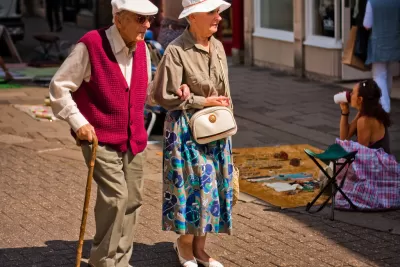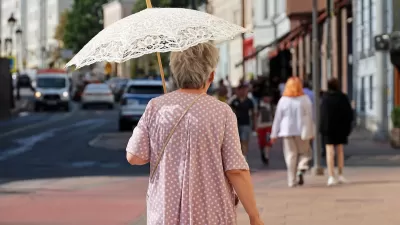The elderly population in cities is growing, and research points to the health benefits of an active, connected lifestyle. So why are cities still so inhospitable to aging?

Anne Karpf writes about why many older people see the city as a hostile place. "Cities are designed for a mythical average person – super-mobile, without dependents or disabilities but with a cast-iron bladder. This person is more likely to be young than old. And yet by 2030, two-thirds of the world's population will be living in cities and, in high-income societies, a quarter of them will be over the age of 60."
Today, that demographic tends to stay in perceived indoor comfort. And that's not good. From the article: "There's a paradox at the heart of cities and old people, and it's this: all the research on health and well-being – and there's reams of it – suggests that old people are more content and more likely to flourish if they go out, participate in local life and have a decent amount of social interaction."
Karpf argues that we perceive aging incorrectly, as an isolated personal "problem" rather than a phase of life with unique public and spatial requirements.
Official overtures to the age-friendly city, says Karpf, often feel like empty sloganeering. But there are many ways cities can open up to old people. "And then I realise that I've been looking in the wrong place – searching for the grand gesture, the sweeping change: age-friendly by government fiat. In reality, age-friendly changes are taking place all around us at the level where most of us live – locally and hyper-locally." The article details several examples of these local changes in action.
FULL STORY: Our cities must undergo a revolution for older people

Alabama: Trump Terminates Settlements for Black Communities Harmed By Raw Sewage
Trump deemed the landmark civil rights agreement “illegal DEI and environmental justice policy.”

Study: Maui’s Plan to Convert Vacation Rentals to Long-Term Housing Could Cause Nearly $1 Billion Economic Loss
The plan would reduce visitor accommodation by 25% resulting in 1,900 jobs lost.

Planetizen Federal Action Tracker
A weekly monitor of how Trump’s orders and actions are impacting planners and planning in America.

Wind Energy on the Rise Despite Federal Policy Reversal
The Trump administration is revoking federal support for renewable energy, but demand for new projects continues unabated.

Passengers Flock to Caltrain After Electrification
The new electric trains are running faster and more reliably, leading to strong ridership growth on the Bay Area rail system.

Texas Churches Rally Behind ‘Yes in God’s Back Yard’ Legislation
Religious leaders want the state to reduce zoning regulations to streamline leasing church-owned land to housing developers.
Urban Design for Planners 1: Software Tools
This six-course series explores essential urban design concepts using open source software and equips planners with the tools they need to participate fully in the urban design process.
Planning for Universal Design
Learn the tools for implementing Universal Design in planning regulations.
Caltrans
Smith Gee Studio
Institute for Housing and Urban Development Studies (IHS)
City of Grandview
Harvard GSD Executive Education
Toledo-Lucas County Plan Commissions
Salt Lake City
NYU Wagner Graduate School of Public Service





























